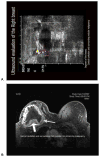Papillary carcinoma of the breast: an overview
- PMID: 20524058
- PMCID: PMC3244819
- DOI: 10.1007/s10549-010-0961-5
Papillary carcinoma of the breast: an overview
Abstract
Papillary carcinoma of the breast represents approximately 0.5% of all newly diagnosed cases of breast cancer. The prevalence of both invasive and in situ papillary carcinoma seems to be greater in older postmenopausal women and, in relative terms, in males. Histologic features of the tumor include cellular proliferations surrounding fibrovascular cores, with or without invasion. In this review, characteristics of both in situ and invasive disease are outlined. Immunohistochemical analyses of papillary carcinoma suggest the utility of markers such as smooth muscle myosin heavy chain, calponin, p63, and high molecular weight keratins, which can characterize the myoepithelial cell layer. With respect to radiographic evaluation of papillary carcinoma, ultrasonography is the most extensively studied imaging modality, though magnetic resonance mammography has potential utility. Available data suggest improved outcome for papillary carcinoma as compared to invasive ductal carcinoma. Treatment-related information for patients with papillary carcinoma is limited, and patterns noted in available series suggest a variable approach to this disease. The scarcity of information underscores the need for further treatment- and outcome-related studies in papillary carcinoma of the breast.
Figures










References
-
- Jemal A, Siegel R, Ward E, Hao Y, Xu J, Thun MJ. Cancer Statistics, 2009. CA A Cancer Journal for Clinicians. 2009;59(4):225–49. - PubMed
-
- Louwman MWJ, Vriezen M, Beek MWPMv, Nolthenius-Puylaert MCBJET, Sangen MJCvd, Roumen RM, et al. Uncommon breast tumors in perspective: Incidence, treatment and survival in the Netherlands. International Journal of Cancer. 2007;121(1):127–35. - PubMed
-
- McCulloch GL, Evans AJ, Yeoman L. Radiological features of papillary carcinoma of the breast. Clin Radiol. 1997;73:865–8. - PubMed
-
- Mulligan AM, O’Malley FP. Papillary lesions of the breast: a review. Adv Anat Pathol. 2007 Mar;14(2):108–19. - PubMed
Publication types
MeSH terms
Grants and funding
LinkOut - more resources
Full Text Sources
Medical

